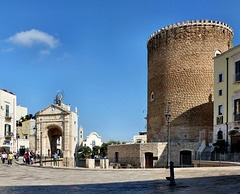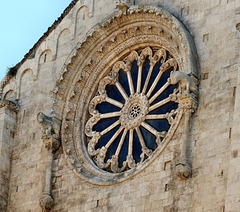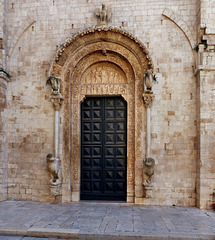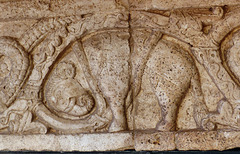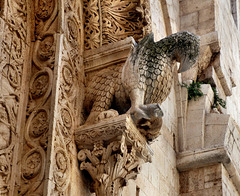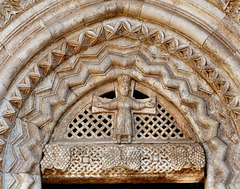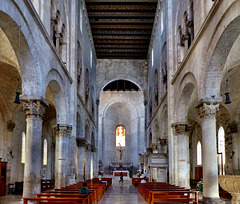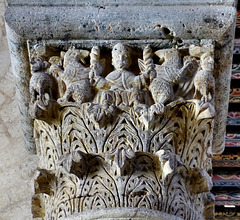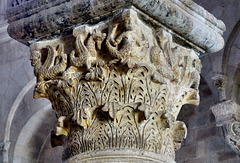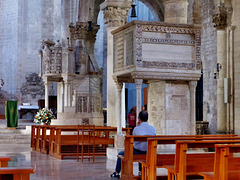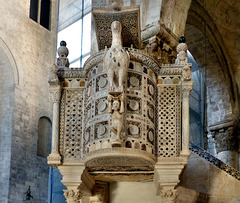
Puglia - Apulia - Apulien
Travelling slowly in Southern Italy.
Bitonto - Chiesa del Crocifisso
| |
|
|
Bitonto, today a city of a population of about 55000, was probably founded by Greek settlers. Traces of a city wall dating to the 5th and 4th century BC were found. Legends tell that the name Bitonto is connected to an Illyrian king named Botone. Later "Civitas Butuntinenses" became a self-governing Roman municipium,
A Paleochristian basilica existed very early. During the 9th century, Bitonto successfully withstood a Saracen raid but got destroyed by Byzantine troops in 975. The Normans took over Apulia. In the 11th and 12th century. Under the rule of the Normans of Roger II of Sicily, William I of Sicily (aka William the Wicked) and William II of Sicily (aka William the Good), the city prospered and got new walls.
In 1227, Bitonto was the scene of ex-communication of Frederick II accused by pope Gregory IX of having come to terms with the sultan al-Malik al-Kamil.
The construction of the Chiesa del Crocifisso started in 1664. It replaced an older chapel that had fresco of the Crucifixion, that was considered miraculous. Following the increase in devotion to the sacred image, the original building had become insufficient for the needs of worship.
The church is built on an original Greek cross plan with domes.
Bitonto - Torrione angioino
| |
|
|
Bitonto, today a city of a population of about 55000, was probably founded by Greek settlers. Traces of a city wall dating to the 5th and 4th century BC were found. Legends tell that the name Bitonto is connected to an Illyrian king named Botone. Later "Civitas Butuntinenses" became a self-governing Roman municipium,
A Paleochristian basilica existed very early. During the 9th century, Bitonto successfully withstood a Saracen raid but got destroyed by Byzantine troops in 975. The Normans took over Apulia. In the 11th and 12th century. Under the rule of the Normans of Roger II of Sicily, William I of Sicily (aka William the Wicked) and William II of Sicily (aka William the Good), the city prospered and got new walls.
In 1227, Bitonto was the scene of ex-communication of Frederick II accused by pope Gregory IX of having come to terms with the sultan al-Malik al-Kamil.
-
The massive "Torrione angioino" dates to the 14th century. It was one of 28 watch- and defence towers around the town. A prison was in the basement of this tower, that is about 24 meters high. The walls are up to 5 meters thick.
Seen to the left is the "Porta Baresana", erected in the 16th century.
Bitonto - Concattedrale di Bitonto
| |
|
Bitonto, today a city of a population of about 55000, was probably founded by Greek settlers. Traces of a city wall dating to the 5th and 4th century BC were found. Later "Civitas Butuntinenses" became a self-governing Roman municipium,
During the 9th century, Bitonto successfully withstood a Saracen raid but got destroyed by Byzantine troops in 975. The Normans took over Apulia. In the 11th and 12th century. Under the rule of the Normans of Roger II of Sicily, William I of Sicily (aka William the Wicked) and William II of Sicily (aka William the Good), the city prospered and got new walls.
In 1227, Bitonto was the scene of ex-communication of Frederick II accused by pope Gregory IX of having come to terms with the sultan al-Malik al-Kamil.
-
The Bitonto Cathedral, dedicated to San Valentino, was erected 1175/1200 in the centre of the city. The construction was probably influenced by the "Basilica of San Nicola" in Bari and was done in the typical "Apulian Romanesque" style.
It is proven that the bishopric existed in 1089, though the crypt of the cathedral has remains of a 5th-century church.
There are three portals. The central one has a double archivolt, adorned with animal and vegetable figures, on which stands an overarch, richly carved with acanthus leaves and surmounted by a pelican, a bird that symbolizes the generosity of the Church. The overarch is supported by a pair of stone griffins holding prey between the claws. The whole is in turn supported by columns resting on lions.
Bitonto - Concattedrale di Bitonto
| |
|
|
Bitonto, today a city of a population of about 55000, was probably founded by Greek settlers. Traces of a city wall dating to the 5th and 4th century BC were found. Legends tell that the name Bitonto is connected to an Illyrian king named Botone. Later "Civitas Butuntinenses" became a self-governing Roman municipium,
A Paleochristian basilica existed very early. During the 9th century, Bitonto successfully withstood a Saracen raid but got destroyed by Byzantine troops in 975. The Normans took over Apulia. In the 11th and 12th century. Under the rule of the Normans of Roger II of Sicily, William I of Sicily (aka William the Wicked) and William II of Sicily (aka William the Good), the city prospered and got new walls.
In 1227, Bitonto was the scene of ex-communication of Frederick II accused by pope Gregory IX of having come to terms with the sultan al-Malik al-Kamil.
-
The Bitonto Cathedral, dedicated to San Valentino, was erected 1175/1200 in the centre of the city. The construction was probably influenced by the "Basilica of San Nicola" in Bari and was done in the typical "Apulian Romanesque" style.
It is proven that the bishopric existed in 1089, though the crypt of the cathedral has remains of a 5th-century church.
There are three portals. The central one has a double archivolt, adorned with animal and vegetable figures, on which stands an overarch, richly carved with acanthus leaves and surmounted by a pelican, a bird that symbolizes the generosity of the Church. The overarch is supported by a pair of stone griffins holding prey between the claws. The whole is in turn supported by columns resting on lions.
The rose window above is the oldest in Apulia.
Bitonto - Concattedrale di Bitonto
| |
|
|
|
Bitonto, today a city of a population of about 55000, was probably founded by Greek settlers. Traces of a city wall dating to the 5th and 4th century BC were found. Legends tell that the name Bitonto is connected to an Illyrian king named Botone. Later "Civitas Butuntinenses" became a self-governing Roman municipium,
A Paleochristian basilica existed very early. During the 9th century, Bitonto successfully withstood a Saracen raid but got destroyed by Byzantine troops in 975. The Normans took over Apulia. In the 11th and 12th century. Under the rule of the Normans of Roger II of Sicily, William I of Sicily (aka William the Wicked) and William II of Sicily (aka William the Good), the city prospered and got new walls.
In 1227, Bitonto was the scene of ex-communication of Frederick II accused by pope Gregory IX of having come to terms with the sultan al-Malik al-Kamil.
-
The Bitonto Cathedral, dedicated to San Valentino, was erected 1175/1200 in the centre of the city. The construction was probably influenced by the "Basilica of San Nicola" in Bari and was done in the typical "Apulian Romanesque" style.
It is proven that the bishopric existed in 1089, though the crypt of the cathedral has remains of a 5th-century church.
There are three portals. Seen here is the central one, that has a double archivolt, adorned with animal and vegetable figures, on which stands an overarch, richly carved with acanthus leaves and surmounted by a pelican, a bird that symbolizes the generosity of the Church. The overarch is supported by a pair of stone griffins holding prey between the claws. The whole is in turn supported by columns resting on lions.
Bitonto - Concattedrale di Bitonto
| |
|
|
Bitonto, today a city of a population of about 55000, was probably founded by Greek settlers. Traces of a city wall dating to the 5th and 4th century BC were found. Legends tell that the name Bitonto is connected to an Illyrian king named Botone. Later "Civitas Butuntinenses" became a self-governing Roman municipium,
A Paleochristian basilica existed very early. During the 9th century, Bitonto successfully withstood a Saracen raid but got destroyed by Byzantine troops in 975. The Normans took over Apulia. In the 11th and 12th century. Under the rule of the Normans of Roger II of Sicily, William I of Sicily (aka William the Wicked) and William II of Sicily (aka William the Good), the city prospered and got new walls.
In 1227, Bitonto was the scene of ex-communication of Frederick II accused by pope Gregory IX of having come to terms with the sultan al-Malik al-Kamil.
-
The Bitonto Cathedral, dedicated to San Valentino, was erected 1175/1200 in the centre of the city. The construction was probably influenced by the "Basilica of San Nicola" in Bari and was done in the typical "Apulian Romanesque" style.
It is proven that the bishopric existed in 1089, though the crypt of the cathedral has remains of a 5th-century church.
There are three portals. The central one has wonderful tympanum, seen here. The lintel has the "Annunciation", the "Visitation", the "Adoration of the Magi" and the "Presentation in the Temple". Note that the Magi have their names written. The scene above is interpreted as an "Anastasia", the "Harrowing of Hell". Jesus descended to hell to bring salvation to all of the righteous who had died since the beginning of the world
Bitonto - Concattedrale di Bitonto
| |
|
Bitonto, today a city of a population of about 55000, was probably founded by Greek settlers. Traces of a city wall dating to the 5th and 4th century BC were found. Legends tell that the name Bitonto is connected to an Illyrian king named Botone. Later "Civitas Butuntinenses" became a self-governing Roman municipium,
A Paleochristian basilica existed very early. During the 9th century, Bitonto successfully withstood a Saracen raid but got destroyed by Byzantine troops in 975. The Normans took over Apulia. In the 11th and 12th century. Under the rule of the Normans of Roger II of Sicily, William I of Sicily (aka William the Wicked) and William II of Sicily (aka William the Good), the city prospered and got new walls.
In 1227, Bitonto was the scene of ex-communication of Frederick II accused by pope Gregory IX of having come to terms with the sultan al-Malik al-Kamil.
-
The Bitonto Cathedral, dedicated to San Valentino, was erected 1175/1200 in the centre of the city. The construction was probably influenced by the "Basilica of San Nicola" in Bari and was done in the typical "Apulian Romanesque" style.
It is proven that the bishopric existed in 1089, though the crypt of the cathedral has remains of a 5th-century church.
There are three portals. The central one has a double archivolt, that is densely populated with animal and vegetable figures. Some of them like these mermaids a mythical.
Bitonto - Concattedrale di Bitonto
| |
|
|
|
Bitonto, today a city of a population of about 55000, was probably founded by Greek settlers. Traces of a city wall dating to the 5th and 4th century BC were found. Legends tell that the name Bitonto is connected to an Illyrian king named Botone. Later "Civitas Butuntinenses" became a self-governing Roman municipium,
A Paleochristian basilica existed very early. During the 9th century, Bitonto successfully withstood a Saracen raid but got destroyed by Byzantine troops in 975. The Normans took over Apulia. In the 11th and 12th century. Under the rule of the Normans of Roger II of Sicily, William I of Sicily (aka William the Wicked) and William II of Sicily (aka William the Good), the city prospered and got new walls.
In 1227, Bitonto was the scene of ex-communication of Frederick II accused by pope Gregory IX of having come to terms with the sultan al-Malik al-Kamil.
-
The Bitonto Cathedral, dedicated to San Valentino, was erected 1175/1200 in the centre of the city. The construction was probably influenced by the "Basilica of San Nicola" in Bari and was done in the typical "Apulian Romanesque" style.
It is proven that the bishopric existed in 1089, though the crypt of the cathedral has remains of a 5th-century church.
There are three portals. The central one has a double archivolt, that is densely populated with animal and vegetable figures.
I have tilted the photo by 90°, to give a better impression of this elephant. Emperor Frederick II was the owner of the "Cremona Elephant", a present he had received from Al-Kamil. The "Cremona Elephant" was the second elephant in Europe after Roman times. The first was Charlemagnes "Abul Abbas". Frederick II presented the "Cremona Elephant" in his triumph parades.
As this elephant is anatomically pretty precise - it is probably the Cremona Elephant.
Bitonto - Concattedrale di Bitonto
| |
|
|
Bitonto, today a city of a population of about 55000, was probably founded by Greek settlers. Traces of a city wall dating to the 5th and 4th century BC were found. Legends tell that the name Bitonto is connected to an Illyrian king named Botone. Later "Civitas Butuntinenses" became a self-governing Roman municipium,
A Paleochristian basilica existed very early. During the 9th century, Bitonto successfully withstood a Saracen raid but got destroyed by Byzantine troops in 975. The Normans took over Apulia. In the 11th and 12th century. Under the rule of the Normans of Roger II of Sicily, William I of Sicily (aka William the Wicked) and William II of Sicily (aka William the Good), the city prospered and got new walls.
In 1227, Bitonto was the scene of ex-communication of Frederick II accused by pope Gregory IX of having come to terms with the sultan al-Malik al-Kamil.
-
The Bitonto Cathedral, dedicated to San Valentino, was erected 1175/1200 in the centre of the city. The construction was probably influenced by the "Basilica of San Nicola" in Bari and was done in the typical "Apulian Romanesque" style.
It is proven that the bishopric existed in 1089, though the crypt of the cathedral has remains of a 5th-century church.
There are three portals. The central one is flanked by two large Griffins. Here is one of them, holding down a ram.
Bitonto - Concattedrale di Bitonto
| |
|
|
Bitonto, today a city of a population of about 55000, was probably founded by Greek settlers. Traces of a city wall dating to the 5th and 4th century BC were found. Legends tell that the name Bitonto is connected to an Illyrian king named Botone. Later "Civitas Butuntinenses" became a self-governing Roman municipium,
A Paleochristian basilica existed very early. During the 9th century, Bitonto successfully withstood a Saracen raid but got destroyed by Byzantine troops in 975. The Normans took over Apulia. In the 11th and 12th century. Under the rule of the Normans of Roger II of Sicily, William I of Sicily (aka William the Wicked) and William II of Sicily (aka William the Good), the city prospered and got new walls.
In 1227, Bitonto was the scene of ex-communication of Frederick II accused by pope Gregory IX of having come to terms with the sultan al-Malik al-Kamil.
-
The Bitonto Cathedral, dedicated to San Valentino, was erected 1175/1200 in the centre of the city. The construction was probably influenced by the "Basilica of San Nicola" in Bari and was done in the typical "Apulian Romanesque" style.
It is proven that the bishopric existed in 1089, though the crypt of the cathedral has remains of a 5th-century church.
The tympanum of the side portal is quite unique. The crucifixion depicts Jesus as a triumphator, wearing a crown. The lintel has giant grapes.
Bitonto - Concattedrale di Bitonto
| |
|
|
Bitonto, today a city of a population of about 55000, was probably founded by Greek settlers. Traces of a city wall dating to the 5th and 4th century BC were found. Legends tell that the name Bitonto is connected to an Illyrian king named Botone. Later "Civitas Butuntinenses" became a self-governing Roman municipium,
A Paleochristian basilica existed very early. During the 9th century, Bitonto successfully withstood a Saracen raid but got destroyed by Byzantine troops in 975. The Normans took over Apulia. In the 11th and 12th century. Under the rule of the Normans of Roger II of Sicily, William I of Sicily (aka William the Wicked) and William II of Sicily (aka William the Good), the city prospered and got new walls.
In 1227, Bitonto was the scene of ex-communication of Frederick II accused by pope Gregory IX of having come to terms with the sultan al-Malik al-Kamil.
-
The Bitonto Cathedral, dedicated to San Valentino, was erected 1175/1200 in the centre of the city. The construction was probably influenced by the "Basilica of San Nicola" in Bari and was done in the typical "Apulian Romanesque" style.
It is proven that the bishopric existed in 1089, though the crypt of the cathedral has remains of a 5th-century church.
Though the middle pillar got lost, it is still visible, that humorous stonemason created this. Two mermaids!
Bitonto - Concattedrale di Bitonto
| |
|
|
Bitonto, today a city of a population of about 55000, was probably founded by Greek settlers. Traces of a city wall dating to the 5th and 4th century BC were found. Legends tell that the name Bitonto is connected to an Illyrian king named Botone. Later "Civitas Butuntinenses" became a self-governing Roman municipium,
A Paleochristian basilica existed very early. During the 9th century, Bitonto successfully withstood a Saracen raid but got destroyed by Byzantine troops in 975. The Normans took over Apulia. In the 11th and 12th century. Under the rule of the Normans of Roger II of Sicily, William I of Sicily (aka William the Wicked) and William II of Sicily (aka William the Good), the city prospered and got new walls.
In 1227, Bitonto was the scene of ex-communication of Frederick II accused by pope Gregory IX of having come to terms with the sultan al-Malik al-Kamil.
-
The Bitonto Cathedral, dedicated to San Valentino, was erected 1175/1200 in the centre of the city. The construction was probably influenced by the "Basilica of San Nicola" in Bari and was done in the typical "Apulian Romanesque" style.
It is proven that the bishopric existed in 1089, though the crypt of the cathedral has remains of a 5th-century church.
The nave, that looks very sober and "Romanesque" now, is the result of a long restoration process. Many Bishops over the centuries had modified the interior. So beginning in the 19th-century side chapels and furnishings got removed. The ambo, now located on the right side (behind the pulpit) was not rebuilt on the original place.
Bitonto - Concattedrale di Bitonto
| |
|
Bitonto, today a city of a population of about 55000, was probably founded by Greek settlers. Traces of a city wall dating to the 5th and 4th century BC were found. Legends tell that the name Bitonto is connected to an Illyrian king named Botone. Later "Civitas Butuntinenses" became a self-governing Roman municipium,
A Paleochristian basilica existed very early. During the 9th century, Bitonto successfully withstood a Saracen raid but got destroyed by Byzantine troops in 975. The Normans took over Apulia. In the 11th and 12th century. Under the rule of the Normans of Roger II of Sicily, William I of Sicily (aka William the Wicked) and William II of Sicily (aka William the Good), the city prospered and got new walls.
In 1227, Bitonto was the scene of ex-communication of Frederick II accused by pope Gregory IX of having come to terms with the sultan al-Malik al-Kamil.
-
The Bitonto Cathedral, dedicated to San Valentino, was erected 1175/1200 in the centre of the city. The construction was probably influenced by the "Basilica of San Nicola" in Bari and was done in the typical "Apulian Romanesque" style.
It is proven that the bishopric existed in 1089, though the crypt of the cathedral has remains of a 5th-century church.
This capital, located on the right side of the nave, depicts Alexander the Great.
A legend in the Alexander romance had Alexander, wishing to see the whole world from above. To do this he harnessed two large birds (or Griffins) with a seat for him between them. To entice them to keep flying higher he placed meat (some say "roasted puppies") on two skewers which he held above their heads.
Bitonto - Concattedrale di Bitonto
| |
|
Bitonto, today a city of a population of about 55000, was probably founded by Greek settlers. Traces of a city wall dating to the 5th and 4th century BC were found. Legends tell that the name Bitonto is connected to an Illyrian king named Botone. Later "Civitas Butuntinenses" became a self-governing Roman municipium,
A Paleochristian basilica existed very early. During the 9th century, Bitonto successfully withstood a Saracen raid but got destroyed by Byzantine troops in 975. The Normans took over Apulia. In the 11th and 12th century. Under the rule of the Normans of Roger II of Sicily, William I of Sicily (aka William the Wicked) and William II of Sicily (aka William the Good), the city prospered and got new walls.
In 1227, Bitonto was the scene of ex-communication of Frederick II accused by pope Gregory IX of having come to terms with the sultan al-Malik al-Kamil.
-
The Bitonto Cathedral, dedicated to San Valentino, was erected 1175/1200 in the centre of the city. The construction was probably influenced by the "Basilica of San Nicola" in Bari and was done in the typical "Apulian Romanesque" style.
It is proven that the bishopric existed in 1089, though the crypt of the cathedral has remains of a 5th-century church.
This capital, located on the right side of the nave, depicts Alexander the Great.
A legend in the Alexander romance had Alexander, wishing to see the whole world from above. To do this he harnessed two large birds (or Griffins) with a seat for him between them. To entice them to keep flying higher he placed meat (some say "roasted puppies") on two skewers which he held above their heads.
Bitonto - Concattedrale di Bitonto
| |
|
|
Bitonto, today a city of a population of about 55000, was probably founded by Greek settlers. Traces of a city wall dating to the 5th and 4th century BC were found. Legends tell that the name Bitonto is connected to an Illyrian king named Botone. Later "Civitas Butuntinenses" became a self-governing Roman municipium,
A Paleochristian basilica existed very early. During the 9th century, Bitonto successfully withstood a Saracen raid but got destroyed by Byzantine troops in 975. The Normans took over Apulia. In the 11th and 12th century. Under the rule of the Normans of Roger II of Sicily, William I of Sicily (aka William the Wicked) and William II of Sicily (aka William the Good), the city prospered and got new walls.
In 1227, Bitonto was the scene of ex-communication of Frederick II accused by pope Gregory IX of having come to terms with the sultan al-Malik al-Kamil.
-
The Bitonto Cathedral, dedicated to San Valentino, was erected 1175/1200 in the centre of the city. The construction was probably influenced by the "Basilica of San Nicola" in Bari and was done in the typical "Apulian Romanesque" style.
It is proven that the bishopric existed in 1089, though the crypt of the cathedral has remains of a 5th-century church.
This capital is densely populated with mythical creatures. Mermaids, Griffins and winged creatures with human heads, covered with scales.
Bitonto - Concattedrale di Bitonto
| |
|
|
Bitonto, today a city of a population of about 55000, was probably founded by Greek settlers. Traces of a city wall dating to the 5th and 4th century BC were found. Legends tell that the name Bitonto is connected to an Illyrian king named Botone. Later "Civitas Butuntinenses" became a self-governing Roman municipium,
A Paleochristian basilica existed very early. During the 9th century, Bitonto successfully withstood a Saracen raid but got destroyed by Byzantine troops in 975. The Normans took over Apulia. In the 11th and 12th century. Under the rule of the Normans of Roger II of Sicily, William I of Sicily (aka William the Wicked) and William II of Sicily (aka William the Good), the city prospered and got new walls.
In 1227, Bitonto was the scene of ex-communication of Frederick II accused by pope Gregory IX of having come to terms with the sultan al-Malik al-Kamil.
-
The Bitonto Cathedral, dedicated to San Valentino, was erected 1175/1200 in the centre of the city. The construction was probably influenced by the "Basilica of San Nicola" in Bari and was done in the typical "Apulian Romanesque" style.
It is proven that the bishopric existed in 1089, though the crypt of the cathedral has remains of a 5th-century church.
-
Seen on the right are the pulpit and the marble ambo, a combined pulpit and lectern, a masterpiece of medieval Apulian stone carving.
Originally the ambo was placed on the right side of the nave but during the Baroque alteration of the church, the ambo was dismantled in the 17th century. Most, but not all parts of the ambo survived, in 1720 the ambo was assembled again at the place, where it is now.
Bitonto - Concattedrale di Bitonto
| |
|
|
Bitonto, today a city of a population of about 55000, was probably founded by Greek settlers. Traces of a city wall dating to the 5th and 4th century BC were found. Legends tell that the name Bitonto is connected to an Illyrian king named Botone. Later "Civitas Butuntinenses" became a self-governing Roman municipium,
A Paleochristian basilica existed very early. During the 9th century, Bitonto successfully withstood a Saracen raid but got destroyed by Byzantine troops in 975. The Normans took over Apulia. In the 11th and 12th century. Under the rule of the Normans of Roger II of Sicily, William I of Sicily (aka William the Wicked) and William II of Sicily (aka William the Good), the city prospered and got new walls.
In 1227, Bitonto was the scene of ex-communication of Frederick II accused by pope Gregory IX of having come to terms with the sultan al-Malik al-Kamil.
-
The Bitonto Cathedral, dedicated to San Valentino, was erected 1175/1200 in the centre of the city. The construction was probably influenced by the "Basilica of San Nicola" in Bari and was done in the typical "Apulian Romanesque" style.
It is proven that the bishopric existed in 1089, though the crypt of the cathedral has remains of a 5th-century church.
-
The marble ambo, a combined pulpit and lectern, a masterpiece of medieval Apulian stone carving.
Originally the ambo was placed on the right side of the nave but during the Baroque alteration of the church, the ambo was dismantled in the 17th century. Most, but not all parts of the ambo survived, in 1720 the ambo was assembled again at the place, where it is now.
A large eagle is supported by a human caryatid. The eagle has lost some of the coloured beads, that once adorned it. On the small pillars, left and right, are the symbols of the four evangelists. Here visible are only two of them. Note the large inscription "NICOLAUS MAGISTER", as this is a signature.
Bitonto - Concattedrale di Bitonto
| |
|
|
Bitonto, today a city of a population of about 55000, was probably founded by Greek settlers. Traces of a city wall dating to the 5th and 4th century BC were found. Legends tell that the name Bitonto is connected to an Illyrian king named Botone. Later "Civitas Butuntinenses" became a self-governing Roman municipium,
A Paleochristian basilica existed very early. During the 9th century, Bitonto successfully withstood a Saracen raid but got destroyed by Byzantine troops in 975. The Normans took over Apulia. In the 11th and 12th century. Under the rule of the Normans of Roger II of Sicily, William I of Sicily (aka William the Wicked) and William II of Sicily (aka William the Good), the city prospered and got new walls.
In 1227, Bitonto was the scene of ex-communication of Frederick II accused by pope Gregory IX of having come to terms with the sultan al-Malik al-Kamil.
-
The Bitonto Cathedral, dedicated to San Valentino, was erected 1175/1200 in the centre of the city. The construction was probably influenced by the "Basilica of San Nicola" in Bari and was done in the typical "Apulian Romanesque" style.
It is proven that the bishopric existed in 1089, though the crypt of the cathedral has remains of a 5th-century church.
-
The marble ambo, a combined pulpit and lectern, a masterpiece of medieval Apulian stone carving.
Originally the ambo was placed on the right side of the nave but during the Baroque alteration of the church, the ambo was dismantled in the 17th century. Most, but not all parts of the ambo survived, in 1720 the ambo was assembled again at the place, where it is now.
A large eagle is supported by a human caryatid. On the small pillars, left and right are the symbols of two evangelists. At the bottom a long inscription, what is the signature of the artist (or the leader of the studio). HOC OPUS FECIT NICOLAUS SACERDOS ET MAGISTER ANNO MILLESIMO DUCENTESIMO VICESIMO NON I(N)DICTIONIS SECUNDE = This work was done by priest and master Nicolaus in 1229.
Jump to top
RSS feed- Latest items - Subscribe to the latest items added to this album
- ipernity © 2007-2024
- Help & Contact
|
Club news
|
About ipernity
|
History |
ipernity Club & Prices |
Guide of good conduct
Donate | Group guidelines | Privacy policy | Terms of use | Statutes | In memoria -
Facebook
Twitter


